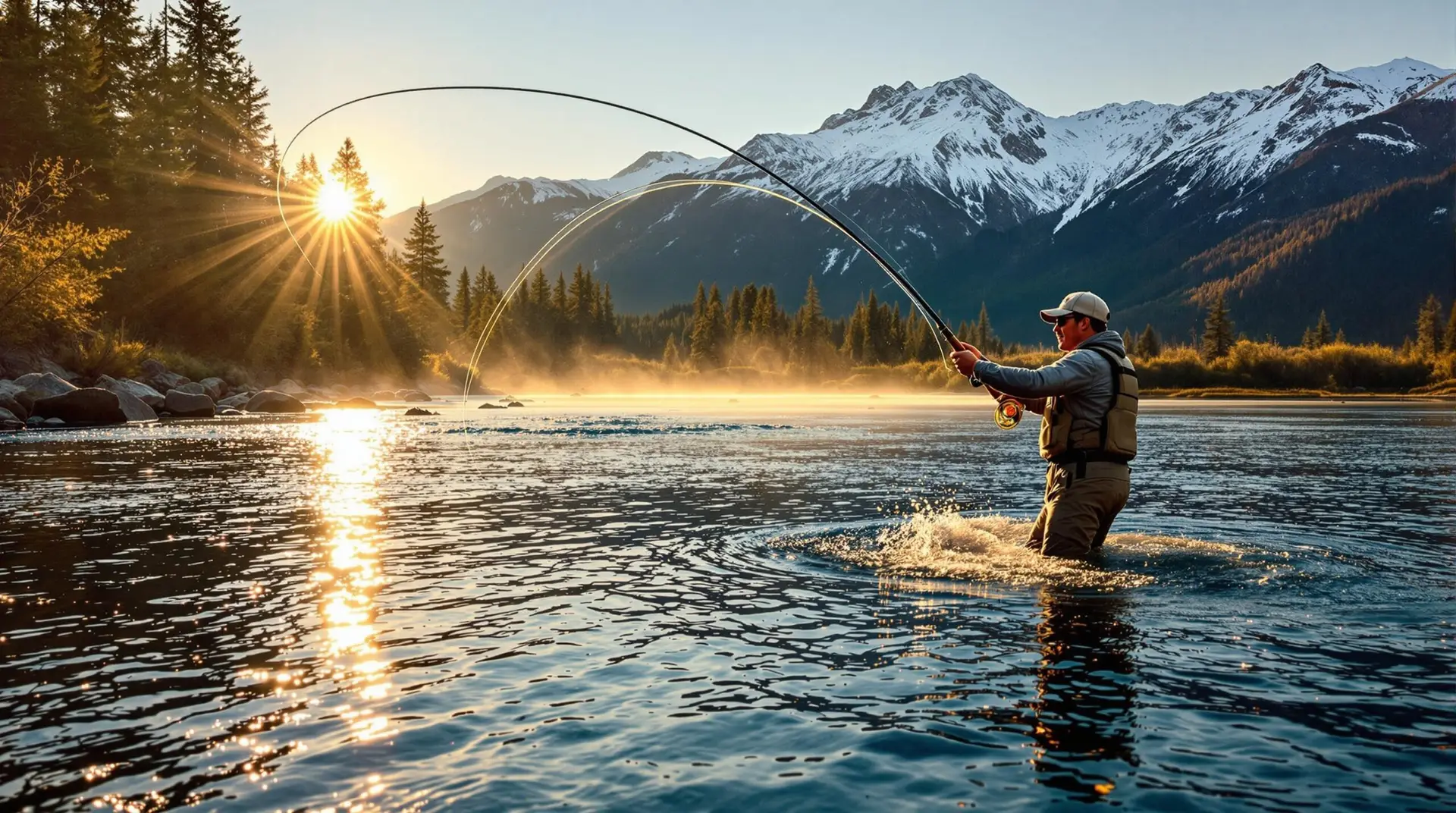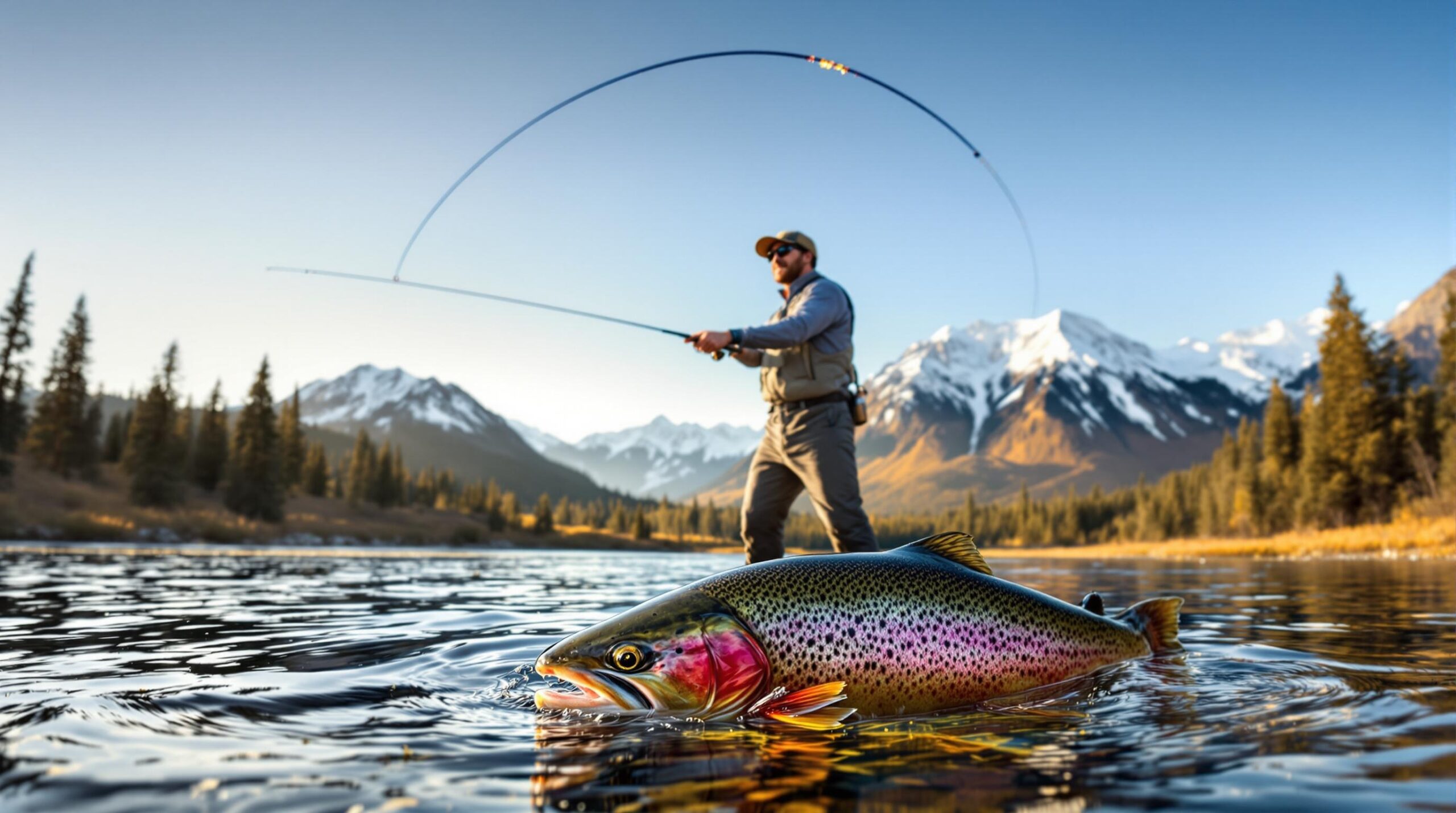According to the Washington Insiders fly fishing guide, Washington State boasts over 70,439 miles of rivers and countless lakes, making it one of the most diverse and productive regions for fly fishing in the Pacific Northwest. Fly fishing in Washington state offers anglers an exceptional combination of stunning landscapes, abundant fish populations, and year-round opportunities that attract both novice and experienced fly fishers seeking world-class experiences.
Key Takeaways
- The Yakima River is Washington state’s only Blue Ribbon trout fishery, offering exceptional year-round fly fishing opportunities
- Olympic Peninsula rivers like the Sol Duc and Hoh provide premier steelhead fly fishing in Washington state
- Seasonal considerations are crucial when planning your fly fishing in Washington state, with different waters peaking at different times
- Conservation efforts and ethical angling practices are essential for preserving Washington’s fly fishing resources
- Many diverse ecosystems from spring creeks to glacier-fed rivers make Washington state a complete fly fishing destination
Top River Destinations for Fly Fishing in Washington State
Washington’s diverse aquatic ecosystems provide incredible opportunities for fly fishing enthusiasts of all skill levels. From glacier-fed streams to desert spring creeks, the variety of waters available makes fly fishing in Washington state a year-round pursuit. Let’s explore some of the most productive and scenic destinations that should be on every angler’s bucket list.
Many of these rivers have gained national recognition for their exceptional fisheries. Research shows that Washington’s unique geography creates ideal habitats for multiple trout species, salmon, and the prized steelhead that draw fly fishers from around the world.
Sol Duc River: Olympic Peninsula Gem for Fly Fishing in Washington State
The Sol Duc River flows through the heart of Olympic National Park, offering some of the most pristine fly fishing in Washington state. This river is renowned for its runs of Chinook, Coho, and the highly prized steelhead. According to Northwest Yachting’s fly fishing guide, the Sol Duc provides year-round fishing opportunities, with winter and spring being particularly productive for steelhead.
What makes the Sol Duc special is its setting among old-growth forests and crystal-clear, glacial-fed waters. The river’s clarity often requires anglers to use bright flies and longer leaders when fly fishing in Washington state’s Olympic Peninsula. Access points near Highway 101 make this river relatively approachable, though some stretches require hiking to reach the best pools.
For those new to the area, guide services like Angler’s Guide Service offer specialized trips that can significantly increase your chances of success on this sometimes challenging but rewarding river.
Yakima River: Washington State’s Only Blue Ribbon Trout Fishery
The Yakima River stands as the crown jewel for fly fishing in Washington state, earning the prestigious Blue Ribbon designation that only elite trout waters receive. This 214-mile river flows through central Washington’s diverse landscapes, offering exceptional habitat for wild rainbow and cutthroat trout.
While the Yakima provides year-round fishing, the peak season runs from April through October when the famous hatches occur. The Pale Morning Dun hatches create some of the most exciting dry-fly fishing opportunities you’ll find anywhere. The river’s consistent flows, thanks to managed releases from upstream reservoirs, make it more predictable than many other Washington waters.
The conservation success story of the Yakima involves collaboration with the Yakama Nation, resulting in reintroduced salmon populations alongside the resident trout. This river is perfect for anglers looking to develop their fly fishing skills with consistent action throughout the season.
Methow River: Premier Cutthroat Destination for Fly Fishing in Washington State
The Methow River in north-central Washington has earned its reputation as a cutthroat paradise for fly fishing in Washington state. This scenic river supports impressive populations of native cutthroat and rainbow trout, with specimens regularly reaching 18-22 inches. The river also sees seasonal runs of Chinook salmon that attract anglers during spring months.
The stretch near Winthrop offers particularly productive water with diverse habitat features including riffles, runs, and deep pools that hold fish year-round. Effective fly patterns for the Methow include PMDs and caddis imitations, with terrestrials like hoppers working well during summer months.
Special regulations protect the native fish stocks, making this a catch-and-release fishery in many sections. These conservation measures have helped maintain the Methow as one of the premier destinations for fly fishing in Washington state focused on wild trout.
Specialized Fly Fishing Waters in Washington State
Beyond the major rivers, Washington offers unique specialized waters that provide distinctive fly fishing experiences. These destinations often require specific techniques and approaches but reward anglers with memorable fishing opportunities not found elsewhere.
Klickitat River: Steelhead and Tribal Waters for Fly Fishing in Washington State
The Klickitat River flows through south-central Washington and is famous for its summer steelhead runs, with fish often weighing 15-20 pounds. The river also supports healthy populations of Chinook and Coho salmon, making it a diverse fishery throughout the year.
What makes the Klickitat unique is its cultural significance to the Yakama Nation, whose traditional dip-net fishing continues alongside modern fly fishing. The “Lower Canyon” stretch near Lyle offers some of the most accessible and productive water for fly anglers.
When planning fly fishing in Washington state’s tribal waters, it’s important to be aware of permit requirements and regulations that may differ from state rules. This respect for tribal sovereignty helps preserve both the fishery and cultural heritage.
Hoh River: Wilderness Steelheading in Olympic National Park
The Hoh River represents the ultimate wilderness steelhead experience for fly fishing in Washington state. Flowing through the heart of Olympic National Park, this river produces some of the largest wild winter steelhead in the Pacific Northwest, drawing anglers from December through March.
The Hoh’s glacial origins mean anglers often face challenging conditions with silt-laden water requiring high-visibility intruder flies and adapted techniques. The river also hosts excellent sea-run cutthroat fishing during summer months when water conditions improve.
Conservation within the national park boundaries has helped protect this iconic fishery. Washington Department of Fish and Wildlife data shows that proper catch-and-release protocols are essential for preserving these remarkable fish for future generations.
Rocky Ford Creek: Trophy Rainbow Trout on a Spring Creek
Rocky Ford Creek offers a completely different experience from Washington’s rivers. This desert spring creek near Ephrata is famous for its giant rainbow trout, with fish averaging 18-24 inches. The creek’s crystal-clear, spring-fed waters create exceptional sight-fishing opportunities year-round.
The technical nature of fly fishing in Washington state’s spring creeks requires precise presentations and specialized patterns. Midge clusters and scud patterns typically produce the best results on these selective fish. The limited access benefits this fishery, keeping pressure manageable despite its popularity.
The groundwater-fed characteristics of Rocky Ford mean consistent water temperatures and clarity throughout the year, making it an excellent option when other waters are blown out or too cold for productive fishing.
Planning Your Fly Fishing Trip in Washington State
To make the most of fly fishing in Washington state, timing your visits to coincide with optimal conditions on your target waters is essential. Each season offers unique opportunities across the state’s diverse watersheds.
Seasonal Guide to Fly Fishing in Washington State
Winter (December-February) provides prime steelhead opportunities on Olympic Peninsula rivers like the Hoh, Bogachiel, and Sol Duc. While challenging weather conditions exist, the chance at wild steelhead draws dedicated anglers.
Spring (March-May) brings the first major hatches to rivers like the Yakima, while early salmon runs begin in some watersheds. This season offers increasing activity with fewer crowds than summer months.
Summer (June-August) is peak season for high mountain lakes and streams, with excellent dry fly fishing on the Yakima and Methow rivers. This is also when neighboring Idaho’s waters become attractive alternatives.
Fall (September-November) features salmon returns throughout the state and less crowded waters as fair-weather anglers depart. The cooling temperatures often trigger increased feeding activity among resident trout.
Conservation and Ethical Fly Fishing in Washington State
Washington’s fisheries face ongoing challenges from habitat degradation, climate change, and fishing pressure. Organizations like the Washington Fly Fishing Club lead conservation initiatives to protect these precious resources.
Proper catch-and-release techniques are essential skills for ethical anglers. This includes using barbless hooks, keeping fish in the water during release, and avoiding fishing over spawning beds (redds) during breeding seasons.
Educational resources like Western Washington University’s fly fishing ethics program demonstrate the growing emphasis on responsible angling as a cornerstone of the sport’s future in Washington state.
Additional Resources for Fly Fishing in Washington State
Making the most of your fly fishing adventures often means tapping into local knowledge and expertise, especially when exploring new waters.
Top Guide Services for Washington State Fly Fishing Adventures
Professional guides can dramatically improve your experience when fly fishing in Washington state, particularly on technical waters or when targeting species like steelhead. Services like Brazda’s Fly Fishing offer specialized trips on the Yakima, Methow, and Klickitat rivers, providing both instruction and access to productive water.
For Olympic Peninsula steelhead, guides at Wild Duc Lodge offer comprehensive packages including accommodations and full-day guided fishing. These experiences typically cost between $450-650 per day but provide invaluable shortcuts to success on challenging waters.
Booking well in advance is essential, especially during peak seasons, as the best guides are often reserved months ahead for prime dates on popular rivers for fly fishing in Washington state.
Emerging Destinations for Fly Fishing in Washington State
Beyond the well-known waters, several emerging destinations offer excellent opportunities with fewer crowds. The Sauk River, a glacier-fed tributary with bull trout and summer steelhead, provides an alternative to more heavily fished waters.
In eastern Washington, the Grande Ronde River offers both smallmouth bass and steelhead opportunities depending on the season. This river has gained popularity among anglers seeking diverse fishing experiences within a single watershed.
The Bogachiel River provides a less crowded alternative to the Hoh River while still offering excellent steelhead fishing. Special regulations and access considerations apply to these waters, so research before visiting is advisable.
The Future of Fly Fishing in Washington State
Washington’s fly fishing legacy continues to evolve through a combination of conservation efforts, habitat restoration, and community engagement. The collaboration between tribes, conservation organizations, and state agencies creates hope for sustainable fisheries despite growing pressures.
Climate change presents significant challenges, particularly for cold-water species like steelhead and trout. However, increased awareness and protective measures demonstrate a commitment to preserving these resources for future generations.
As you explore the diverse waters available for fly fishing in Washington state, remember that each angler becomes a steward of these precious resources. Practicing catch-and-release, supporting conservation efforts, and respecting regulations all contribute to ensuring these exceptional fisheries remain productive for years to come.
FAQs
When is the best time of year for fly fishing in Washington state?
While fly fishing in Washington state is available year-round, the optimal time depends on your target species. Summer (June-August) offers the best all-around conditions with accessible waters and active fish across most regions. Winter (December-February) is prime for steelhead on Olympic Peninsula rivers, while spring and fall provide excellent opportunities with fewer crowds.
Do I need a special license for fly fishing in Washington state?
Yes, you’ll need a Washington State fishing license with appropriate endorsements. Most waters require a freshwater license, while anadromous fish like salmon and steelhead require additional catch record cards. Some waters on tribal lands may require separate permits. Always check the current WDFW regulations before fishing any water.
What are the must-have flies for fly fishing in Washington state?
Essential patterns vary by water and season, but a well-stocked fly box should include: Woolly Buggers (sizes 4-8), Parachute Adams (sizes 12-18), Elk Hair Caddis (sizes 14-18), Prince Nymphs (sizes 12-16), and Copper Johns (sizes 14-18). For steelhead, bring larger patterns like Intruders and Egg Sucking Leeches in sizes 2-6.
Where can beginners learn fly fishing in Washington state?
The Yakima River offers excellent opportunities for beginners with consistent flows and plentiful fish. Rocky Ford Creek provides sight-fishing opportunities that help new anglers learn. Many fly shops like The Avid Angler in Seattle and Red’s Fly Shop on the Yakima offer classes and guided trips specifically designed for beginners.
Are there fly fishing clubs or communities in Washington state?
Yes, Washington has several active fly fishing clubs including the Washington Fly Fishing Club (Seattle), Puget Sound Fly Fishers (Tacoma), and the Columbia Basin Fly Casters. These organizations offer mentorship, conservation opportunities, and regular outings that are perfect for connecting with fellow anglers.
What conservation efforts are protecting fly fishing in Washington state?
Multiple initiatives are underway, including habitat restoration projects by Wild Steelhead Coalition, dam removal efforts on rivers like the Elwha, and collaborative management between tribal nations and state agencies. Catch-and-release regulations on wild steelhead waters and barbless hook requirements are regulatory approaches helping to preserve these fisheries.
Sources:
Columbia Basin Flycasters – “Fly Fishing Around the Tri-Cities”
Western Washington University – “WWU Summer Course Introduces Students to the Art, Science and Ethics of Fly Fishing”
Brazda’s Fly Fishing
Northwest Yachting – “On the Fly”
Washington Department of Fish and Wildlife – “Basic Fishery Management Strategy: Resident and Anadromous Trout in Washington”
Drifthook – “Top 18 Places to Fly Fish in Washington and What Flies to Use”
Washington Fly Fishing Club


